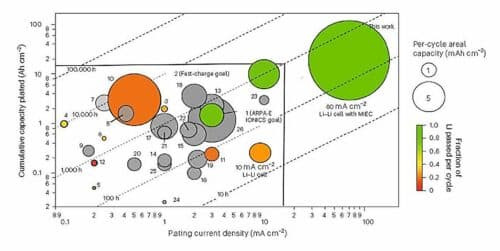Researchers at Maryland Energy Innovation Institute (MEI2) and University of Maryland (UMD) have created a mixed ion- and electron-conducting (MIEC) garnet material.

Current batteries face limits in charging time and range. Fast charging current Li-ion batteries may cause Li-metal plating and dangerous lithium dendrite shorts. Li-metal anodes could overcome these problems, turning plating into a feature and enabling higher energy density for extended EV range. However, lithium dendrite shorts still limit the charging rate of Li-metal anodes.
Researchers at Maryland Energy Innovation Institute (MEI2) and University of Maryland (UMD) have developed a mixed ion- and electron-conducting (MIEC) garnet material. When combined with their earlier developed 3D architecture, it not only met but exceeded the Department of Energy (DOE) Fast-charge goal for Li cycling by a factor of 10.
The Mixed Ionic Electronic Conductor (MIEC) garnet’s porous structure aids in reducing stress on the solid electrolytes (SE) during cycling by uniformly distributing the potential across the surface. This prevents the creation of localized hot spots that might lead to the development of dendrites. This transformative material and structure represent a significant advancement that will have a profound impact on electric vehicles (EVs) and various other applications. With this capability in Li cycling, EVs would have the potential to perform full 100% depth of discharge cycles daily for a decade, exceeding any expected EV lifetime or warranty demands by a considerable margin.
The team have showcased the enhanced rate capability of the lithium metal anode in this work. Achieving such performance was possible through an innovative 3D design and a unique architectural approach. This method paves the way for a new paradigm in designing the next generation of high-energy rechargeable batteries. The effective demonstration of high-rate, dendrite-free Li metal within 3D MIEC structures is anticipated to stimulate the creation of practical solid-state batteries using a “Li-free” anode approach.
The challenge of achieving a reversible high-rate lithium metal anode is a critical obstacle in the development of competitive solid-state batteries. The demonstration of current densities at the elevated levels reported by the team could represent a game-changing advancement.
Reference: George V. Alexander et al, Extreme lithium-metal cycling enabled by a mixed ion- and electron-conducting garnet three-dimensional architecture, Nature Materials (2023). DOI: 10.1038/s41563-023-01627-9








